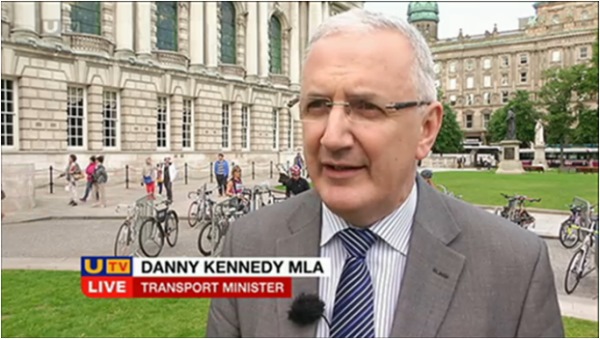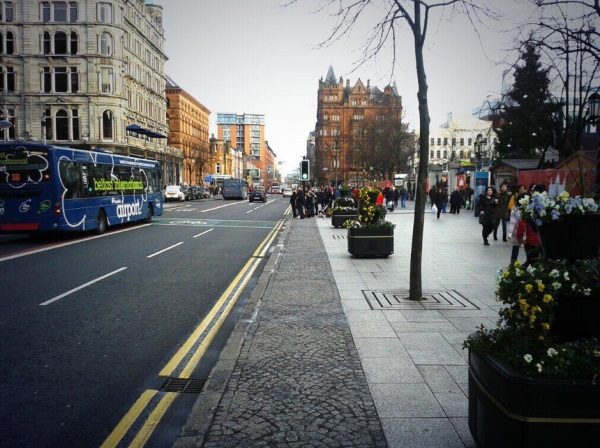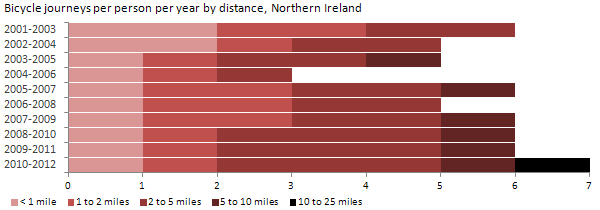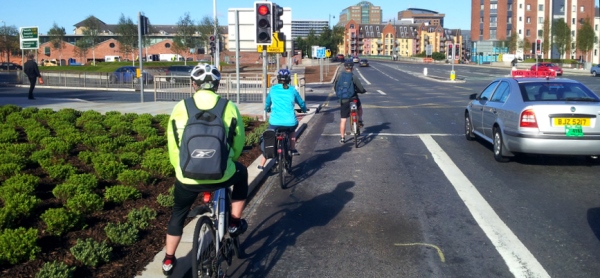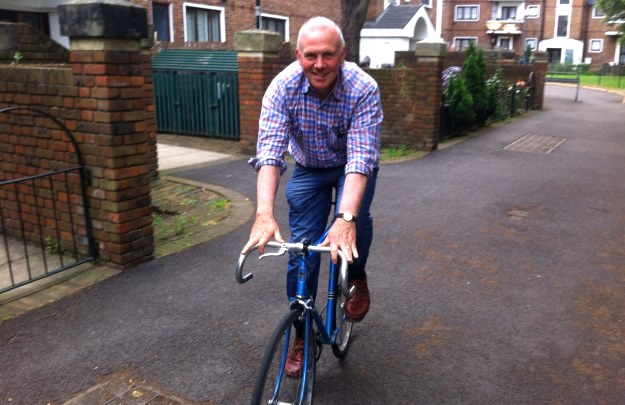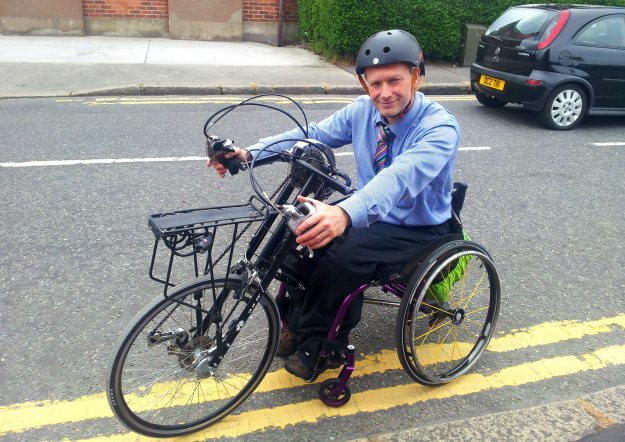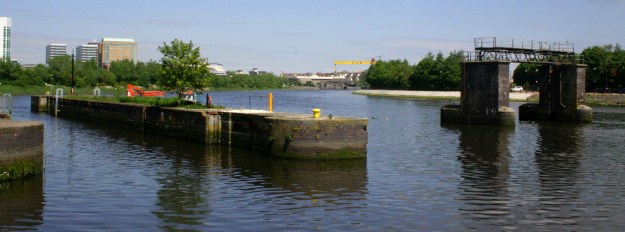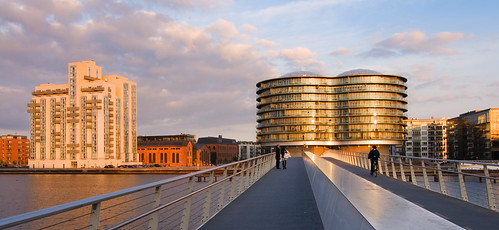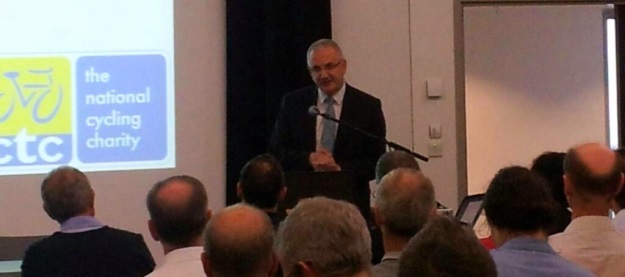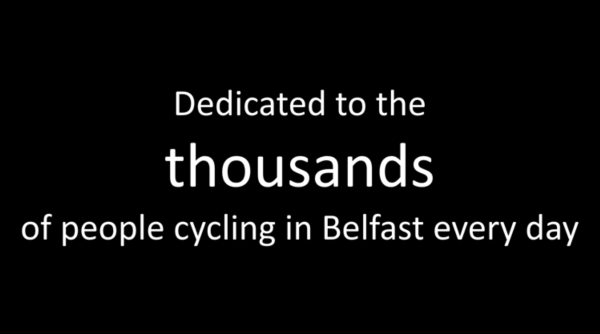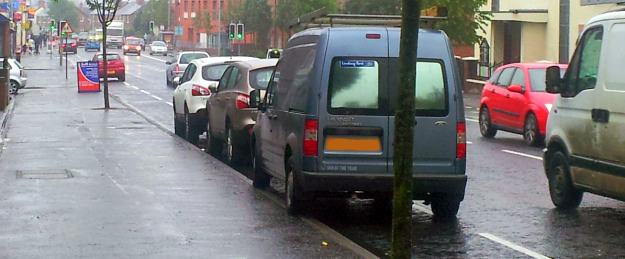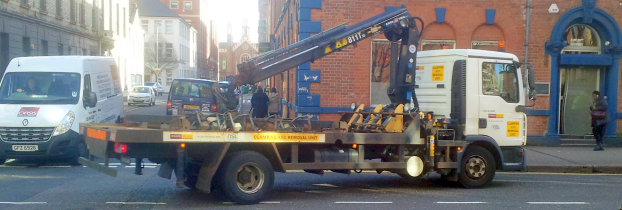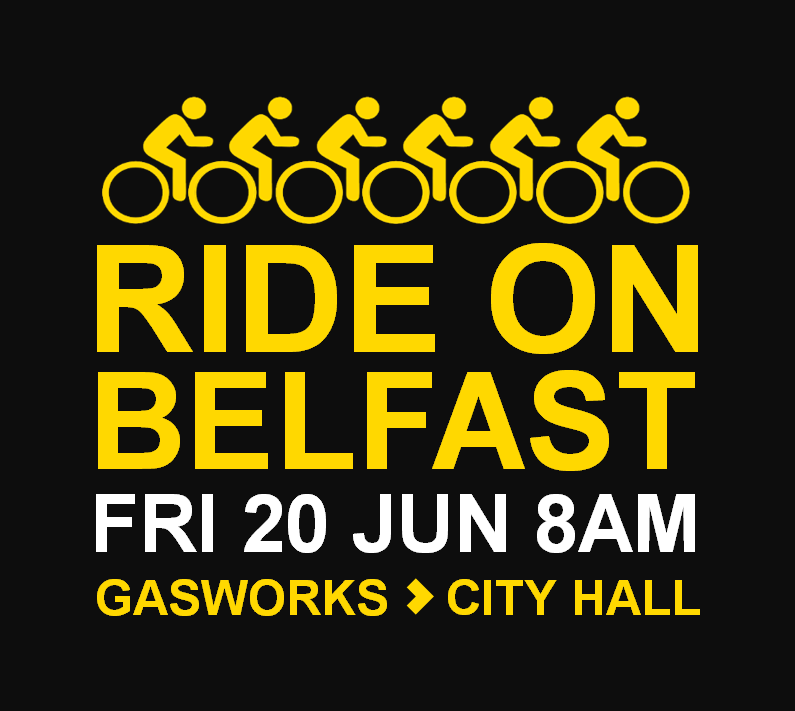
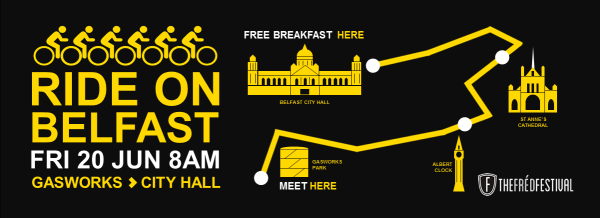
,
On Friday 20th June 2014, the second annual Ride On Belfast event took to the city streets. Last year, around 70 people rode from the Gasworks to the City Hall, inspired by and assembled under the banner of The Fréd Festival. This year the theme was ruthless expansion, with the twin aims of:
- being the biggest peloton in Belfast since the Giro d’Italia
- encouraging people not used to cycle commuting to try it out
See you all at 8AM tomorrow! Ride your bicycle to work; it's so simple, give it a go! #RideOnBelfast pic.twitter.com/B0j8d3g2tf
— NI Greenways (@nigreenways) June 19, 2014
That was the simplest expression of what Ride On Belfast is about – people riding bicycles in Belfast for their own reasons, whether being the most practical way to work, for the school run, for their health or just the enjoyment. It’s not a protest, it’s not ‘taking back’ the roads, it’s not causing aggro to others – just riding a bike.
But to make this year really special, we needed some new, innovative tactics..
The Weather Underground
Belfast is used to long arid summers, heatwaves lasting months and emergency air-drops of Mr Frostie supplies, but Fréd and his goons needed to be sure that precipitation wasn’t going to affect Ride On Belfast. There was nothing for it – with a brass neck, we tweet-bombed all of the finest weather presenters on local television, and Frank Mitchell too.
Right, who's going to be adventurous and give #RideOnBelfast a mention on Thursday evening's forecast? 😉 pic.twitter.com/OYj6PpJx56
— NI Greenways (@nigreenways) June 18, 2014
And by jove, the BBC crew got into the spirit, with Angie Phillips retweeting, Barra Best tweeting his own predictions, and the fabulous Cecilia Daly (the new darling of Belfast cycling) going the extra mile..
@nigreenways how about a wee mention tomorrow morning @BBCgmu
— Cecilia Daly (@WeatherCee) June 18, 2014
And so, the day before Ride On Belfast gathered, we got our first official ‘national’ weather forecast!
[gigya src=”https://abfiles.s3.amazonaws.com/swf/default_player_10.swf” style=”background-color:transparent; display:block; box-shadow:0 0 1px 1px rgba(0, 0, 0, 0.15); min-width:349px; max-width:700px;” flashvars=”image_option=small&imgURL=https%3A%2F%2Fd15mj6e6qmt1na.cloudfront.net%2Fi%2F9638374%2F300x300%2Fc&link_color=%23c70067&mp3Author=nigreenways&mp3Duration=45505.0&mp3LinkURL=https%3A%2F%2Faudioboo.fm%2Fboos%2F2273070-ride-on-belfast-gets-a-personalised-weather-forecast&mp3Time=11.43pm+21+Jun+2014&mp3Title=Ride+On+Belfast+gets+a+personalised+weather+forecast&mp3URL=https%3A%2F%2Faudioboo.fm%2Fboos%2F2273070-ride-on-belfast-gets-a-personalised-weather-forecast.mp3%3Fsource%3Dwordpress&player_theme=dark&rootID=boo_player_1&show_title=true&waveimgURL=https%3A%2F%2Fd15mj6e6qmt1na.cloudfront.net%2Fi%2Fw%2F724171″ width=”600″ height=”150″ allowFullScreen=”true” wmode=”transparent”]
And as it turned out, the weather was just about perfect on the day..
#RideonBelfast at 8am – cycle from the Gasworks to Belfast City Hall via Albert clock and St Anne's cathedral. Dry & sunny, light NW wind
— Cecilia Daly (@WeatherCee) June 20, 2014
Perfect morning for a #RideOnBelfast – Gasworks, 8am. See you there!
— TheFred.cc (@thefredfestival) June 20, 2014
Brinnng, brinnng, happy #RideOnBelfast Day! pic.twitter.com/czFB2lcqDU
— The Thread… (@Belfast_Thread) June 20, 2014
The Gathering
Lovely quiet Belfast streets at 7.30am on a Friday morning; spotted this on way to #RideOnBelfast 🙂 pic.twitter.com/oRnt9eU08r
— NI Greenways (@nigreenways) June 21, 2014
https://twitter.com/ellenfromnowon/status/479874513573019648
This year’s Ride On Belfast was helped by some last minute news from Translink, as their early morning ban on bicycles on trains was eased to accommodate those travelling for the event:
BIKE & TRAINS TOMORROW!
Bikes allowed on all Belfast bound trains tomorrow if journeys ends B4 7.30am.
Take bike on train & meet @ Gasworks— TheFred.cc (@thefredfestival) June 19, 2014
This was a most welcome nod to active travel, and hopefully will give Translink and DRD pause to consider trialling this over a longer period.
Hmmm. 5:50 train to be on time for #RideOnBelfast – this'll be fun…
— Better Call Paul (@paul_beattie) June 19, 2014
Cycle commuters speeding past the Gasworks before #RideOnBelfast this morning #Lagan #skyline pic.twitter.com/Tqx8heOW5d
— NI Greenways (@nigreenways) June 20, 2014
https://twitter.com/BelfastCyclist/status/480028818204536833
It has begun – early birds at #RideOnBelfast pic.twitter.com/SAwQlymBsY
— NI Greenways (@nigreenways) June 20, 2014
https://twitter.com/bernie_stocks/status/479921650725814272
The gathering crowd was impressed to see Northern Ireland’s Transport Minister Danny Kennedy ride into the bunch with his new Cycling Unit in tow. Regular cyclist and MLA Sammy Douglas also joined in.
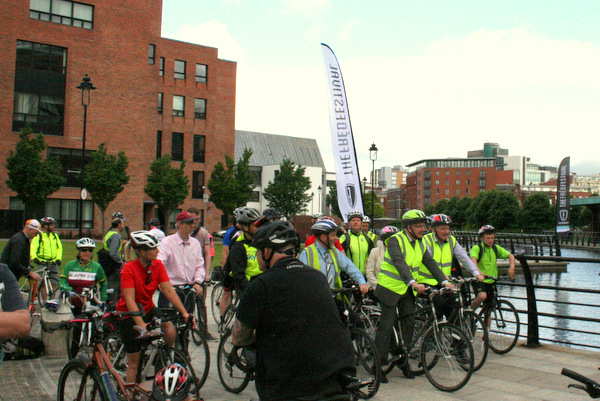
All eyes and ears on Fréd @10ON12 reads the Riot Act before #RideOnBelfast rolls out @thefredfestival pic.twitter.com/k8Sl4e2GTN
— NI Greenways (@nigreenways) June 20, 2014
The Grand Départ
Under severe pressure from hungry commuters, the peloton set off a little earlier than planned. With a tight first turn from the Gasworks green onto the road, the Minister seized his opportunity and put in a devastating early kick. This split the peloton at the Ormeau Road crossing, and the breakaway group was never caught again. Apparently, Danny Kennedy’s sprint finish down Donegall Place was a phenomenal sight.
https://twitter.com/MrVirtualGill/status/479892607603343360
[youtube https://www.youtube.com/watch?v=XbGdaI6zEqc?rel=0&w=600&h=338]
#RideOnBelfast Grand Départ 2014 -that's our Transport Minister leading a decisive early breakaway 🙂 http://t.co/0eplpjSTas
— NI Greenways (@nigreenways) June 20, 2014
On The Open Road
This year Ride On Belfast took an extended trip around Belfast, leading to an iconic roll down Royal Avenue towards the City Hall. The PSNI officers took a relaxed back seat this year, yet the busier junctions were taken with ease. Notable pinch points (again) were the length of time to traverse Shaftesbury Square (not great for cycling at all) and the bus lane at Great Victoria Street (still not great for buses, never mind cycling). Holding the outside lane along Carrick Hill worked to control what was expected to be the busiest and fastest traffic of the ride. The traffic-restricted streets of the city centre were a joy.
[youtube https://www.youtube.com/watch?v=5uxRPmcbSYY?rel=0&w=600&h=338]
Waiting to cross Ormeau Road into Donegall Pass – selfies all round! #RideOnBelfast pic.twitter.com/eeYFqnuepM
— NI Greenways (@nigreenways) June 22, 2014
#RideOnBelfast pic.twitter.com/18wVOfE6TA
— m/ SOX m/ (@simonstockton) June 20, 2014
A half decent street for cycling – the #RideOnBelfast peloton pedalling down Donegall Pass pic.twitter.com/oGQQMYD5du
— NI Greenways (@nigreenways) June 22, 2014
#RideOnBelfast waited forever at Shaftesbury Sq, but bicycles fairly flew round that corner on green pic.twitter.com/pTHvABuPDg
— NI Greenways (@nigreenways) June 22, 2014
Great Victoria Street #RideOnBelfast pic.twitter.com/yDNUv6ok0M
— NI Greenways (@nigreenways) June 20, 2014
The #RideOnBelfast peloton ambles down the Gt Victoria St bus lane (sooo slow!) #BikeWeek pic.twitter.com/RtdQkTvTjQ
— NI Greenways (@nigreenways) June 20, 2014
#RideOnBelfast hits the buffers in the bus lane outside @europahotel for the second year in a row 🙂 pic.twitter.com/om5WS9SQeg
— NI Greenways (@nigreenways) June 20, 2014
https://twitter.com/GeoffCaves/status/479919201080311808
https://twitter.com/jonathan_alban/status/479886080544882688
Hiya @BelTel! We are #RideOnBelfast that noisy bunch who cycled past your offices, ringing bells 🙂 pic.twitter.com/JFHXzzryKt
— NI Greenways (@nigreenways) June 20, 2014
#RideOnBelfast passing Castle Court, lovely quiet Belfast city centre streets 🙂 pic.twitter.com/5gYib04qLZ
— NI Greenways (@nigreenways) June 20, 2014
Belfast City Hall (and that @belfastcc breakfast) on the horizon for the #RideOnBelfast bicyclers pic.twitter.com/uAkHAl6A6U
— NI Greenways (@nigreenways) June 20, 2014
Crossing the finish line into the grounds of Belfast City Hall 🙂 #RideOnBelfast pic.twitter.com/uJO2RROyys
— NI Greenways (@nigreenways) June 20, 2014
Less hi-viz more style: future image of Belfast cycling (albeit with a few more women) #RideOnBelfast pic.twitter.com/jGOctnuENr
— NI Greenways (@nigreenways) June 22, 2014
I liked the bit where we were all riding bikes @thefredfestival @nigreenways #RideOnBelfast pic.twitter.com/bX4KTM72MZ
— Neil Hainsworth (@_neilorangepeel) June 20, 2014
Selfie On Belfast
After the last year with Máirtín Ó Muilleoir as Lord Mayor, Belfast has fallen in love with the selfie. As well as people just taking them for the craic, See.Sense also ran a competition for the best selfie taken by their stand at Belfast City Hall..
https://twitter.com/BelfastAikido/status/479895033630699520
https://twitter.com/KillinchyCC/status/479929158337069056
Here is my attempt at a #RideOnBelfast selfie. pic.twitter.com/cZx2DOfyEu
— James Draper (@JamesTheDraper) June 20, 2014
https://twitter.com/GeoffCaves/status/479915437950763008
#RideOnBelfast @seesense_cc #selfie pic.twitter.com/EqvHMzxV8X
— Leanne (@Fitnotskinny1) June 20, 2014
Cycle more and be as happy as this 😉 #RideOnBelfast @seesense_cc @BelfastAikido @nigreenways @4VentiCiclismo pic.twitter.com/mxi67QkDKv
— Rachel Overton (@Rachel_Overton) June 20, 2014
https://twitter.com/dbinterz/status/479921452708548608
Excellent morning #RideOnBelfast @seesense_cc on a natural high after a morning cycle commute into Belfast @belfastcc pic.twitter.com/iYWhIjE8Jt
— Rachel Overton (@Rachel_Overton) June 20, 2014
https://twitter.com/clairemulv/status/480005258463416320
#RideOnBelfast free breakie! pic.twitter.com/QAzxfXC6a5
— Leanne (@Fitnotskinny1) June 20, 2014
So many great entries received for #RideOnBelfast selfie comp but winner is @_neilorangepeel he was the very first! pic.twitter.com/fVgcnFj7Ij
— See.Sense (@seesense_cc) June 21, 2014
City Hall and well-earned grub
A huge thank you again to Travelwise and Belfast City Council for providing a free breakfast at the Bobbin Cafe (and the new option of a free coffee at Javaman) for those who completed Ride On Belfast. The City Hall grounds became a sea of bicycles for the morning, while local cycle lighting tech firm See.Sense showed off their wares and PSNI bike officers were busy security-marking bicycles for the punters.
Inside the City Hall, the breakfast queue stretched out the door (which is testament to the rise in participation at Ride On Belfast) and we’re all grateful to the Bobbin staff for coping under severe pressure.
#RideOnBelfast main peloton arriving at Belfast City Hall for some breakfast @belfastcc pic.twitter.com/lp958SEG9S
— NI Greenways (@nigreenways) June 20, 2014
Counted 150 on arrival, more came later "@thefredfestival How many bikes at city hall this morning? pic.twitter.com/EjPf75JgV1"
— NI Greenways (@nigreenways) June 20, 2014
https://twitter.com/KillinchyCC/status/479930501453848576
Me parking up for cycle-to-work-day this am. ps I cycle to work everyday. #RideOnBelfast @thefredfestival @belfastcc pic.twitter.com/HbO611eV9t
— Daniel Smith (@belfast_dan) June 20, 2014
Hands down, this year's cutest #RideOnBelfast participant #weebaba #awww 🙂 pic.twitter.com/3OOGG4ksTy
— NI Greenways (@nigreenways) June 20, 2014
Wonderful to meet Belfast's new Lord Mayor @NicholaMallon at our stand at @belfastcc for #RideOnBelfast #cycling pic.twitter.com/6haQBbHfpE
— See.Sense (@seesense_cc) June 20, 2014
Time to get some proper coffee in ye – JAVAMAN brewing up at Belfast City Hall #RideOnBelfast pic.twitter.com/cWsevYHBpJ
— NI Greenways (@nigreenways) June 22, 2014
Getting their free brekkie after #RideOnBelfast @belfastcc pic.twitter.com/BUiRLSbF29
— Cecilia Daly (@WeatherCee) June 20, 2014
Great turnout this morning for @belfastcc Bike To Work Free Breakfast.Bacon must've been good.That was some queue! pic.twitter.com/lV2ogs0p6s
— Nichola Mallon (@NicholaMallon) June 20, 2014
Thanks for the support this morning and to @belfastcc and Travelwise for the breakfast. Long queues but ride was good pic.twitter.com/WhkYmAlIxU
— TheFred.cc (@thefredfestival) June 20, 2014
Great turnout at the #BikersBreakfast this morning, wonderful to see so many cyclists out to enjoy a cycle, a coffee and some breakfast!
— Sarah Fox (@ChiChimouse7) June 20, 2014
https://twitter.com/lobsterbane/status/479917543784996864
The City Hall looked like an Amsterdam train station for a few hours. Shame it only once a year… #RideOnBelfast pic.twitter.com/AktFuaRYZ0
— TheFred.cc (@thefredfestival) June 22, 2014
The Media
Straight after the event, our Twitter traffic was enough to set #RideOnBelfast trending locally – maybe next year “sectarianism” can be beaten by cycling? Little steps..
Yeeoo #RideOnBelfast and @nigreenways now trending in Belfast @TrendsBelfast http://t.co/1cNPVxnwdj pic.twitter.com/yavMNJrDyG
— NI Greenways (@nigreenways) June 20, 2014
Paul Reilly brought the UTV cameras down to see what all the fuss was about, and importantly set the day in context with a reminder of the shocking scene of a child’s bicycle under a truck at Ballyhackamore the day before. Along with the tragic death of 5 year old Conor O’Neill 9 days before, Bike Week had a strong focus on road safety and infrastructure improvement this year.
https://twitter.com/GregorClaus/status/480273772008988672
The Irish News covered the event in its Saturday edition. Might need to check that ear-to-shorthand connection though, as ‘enthusiast’ (a word I’m almost violently resistant to when it comes to practical cycling) somehow crept into a quote. And “giro d’italia” needs capitals. #facepalm
Instead of making a vid at #RideOnBelfast we're getting on the #threadbike Here's a video we made last year tho http://t.co/uLsRPN8Lyh
— The Thread… (@Belfast_Thread) June 19, 2014
The Aftermath
Ride On Belfast turned out to be a really positive, fun event and this was reflected in social media comments directly afterwards. We had new cycling commuters, people trying out cycling for the first time in years, as well as familiar faces.
https://twitter.com/BarryParke/status/479964204578136065
https://twitter.com/donnakmonteith/status/479984227816337409
I now think in order to fit in with the cosmopolitans of #Belfast – I must buy a bike #RideOnBelfast
— Jemma Simpson (@JemmaSimpsonIT) June 20, 2014
https://twitter.com/theflyingfanny/status/479913575453315072
While we couldn't participate in #RideOnBelfast, two CAI staff members huffed and puffed their way into the office in N'breda today!
— CAI Cycling (@CAI_cycling) June 20, 2014
https://twitter.com/lobsterbane/status/479914027989344256
@nigreenways. Lovely cycle, great breakfast, brilliant to see the Big Belfast Peleton! Thank you xx
— Carol Majury (@CarolMajury) June 20, 2014
Good chat today with @sammydouglasmla at the #RideOnBelfast – a real honest to goodness cyclist. Loves the bike.
— TheFred.cc (@thefredfestival) June 20, 2014
Someone at the #RideOnBelfast yesterday had an fine 1980s Moulton AM. That bike is probably the best I've ever seen. pic.twitter.com/dc5b87gmBF
— (John^(iπ))=-1 (@phramewerk) June 21, 2014
https://twitter.com/donnakmonteith/status/480053273609904128
https://twitter.com/lobsterbane/status/479922578476523521
Passed quite a few bike commuters today and saw loads out on their bikes around Belfast #RideOnBelfast
— mountain goat (@mikendcc1808) June 20, 2014
#RideOnBelfast is the irish for #CriticalMass Enjoy!
— #ThinkingOutSideTheBox (@redeader) June 20, 2014
https://twitter.com/ellenfromnowon/status/479913587113492480
@belfastcc Yes ta! Worth the wait Great craic in queue swapping tips+stories with fellow cyclists #RideOnBelfast @seesense_cc @nigreenways
— Rachel Overton (@Rachel_Overton) June 20, 2014
https://twitter.com/ukprototype/status/479951509275566080
#RideOnBelfast made magnificent by all who cycled, possible by @thefredfestival @belfastcc Travelwise pic.twitter.com/IINpWZVIwx
— NI Greenways (@nigreenways) June 20, 2014
https://twitter.com/KillinchyCC/status/479952404700725248
In the end, the various breakaway groups which started from the Gasworks numbered 150, with close to 200 registered for the bicycle breakfast at City Hall. Overall that was a doubling of participation from 2013, which is a credit to all involved – The Fréd Festival, Travelwise (DRD) and Belfast City Council.
